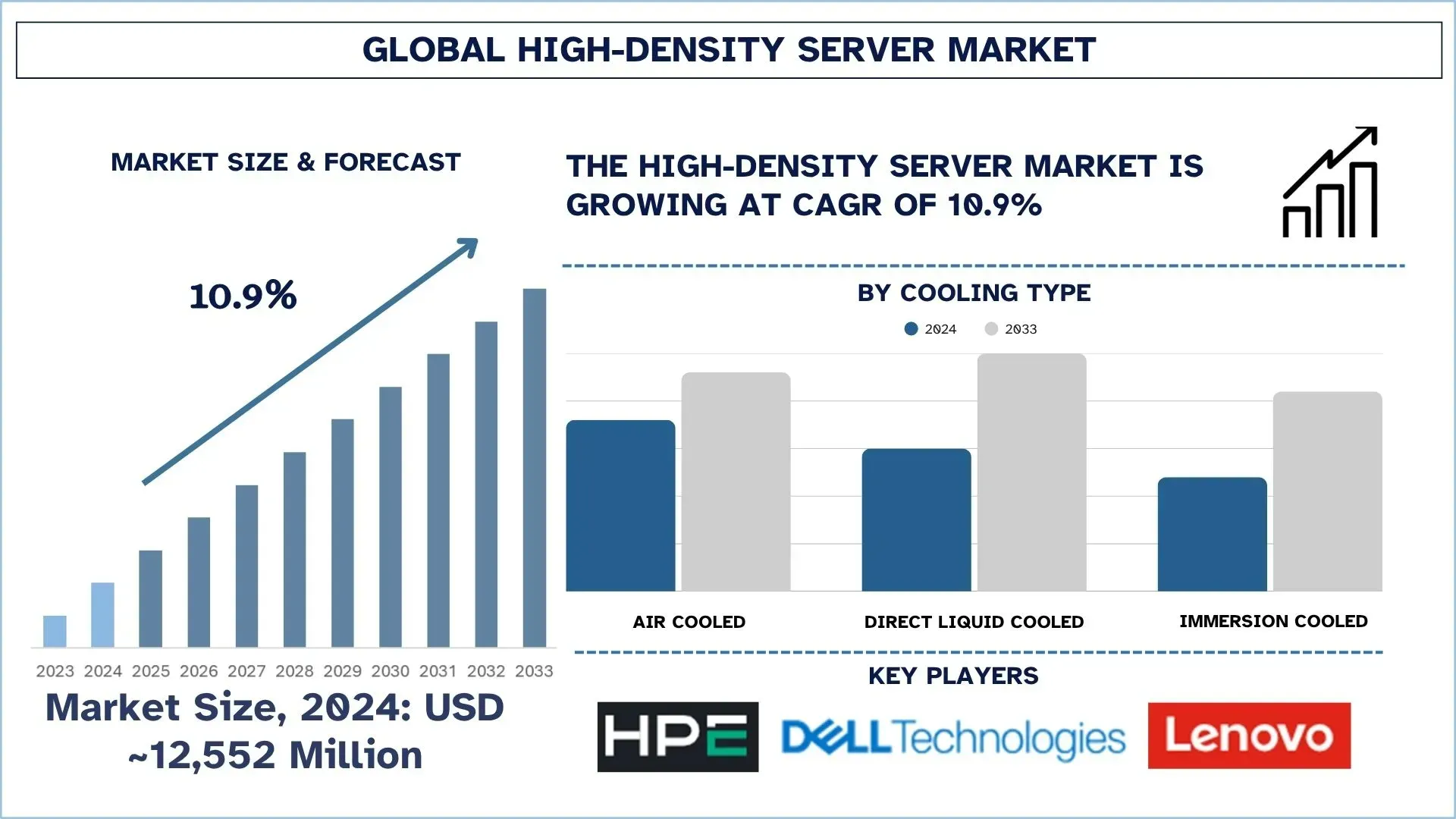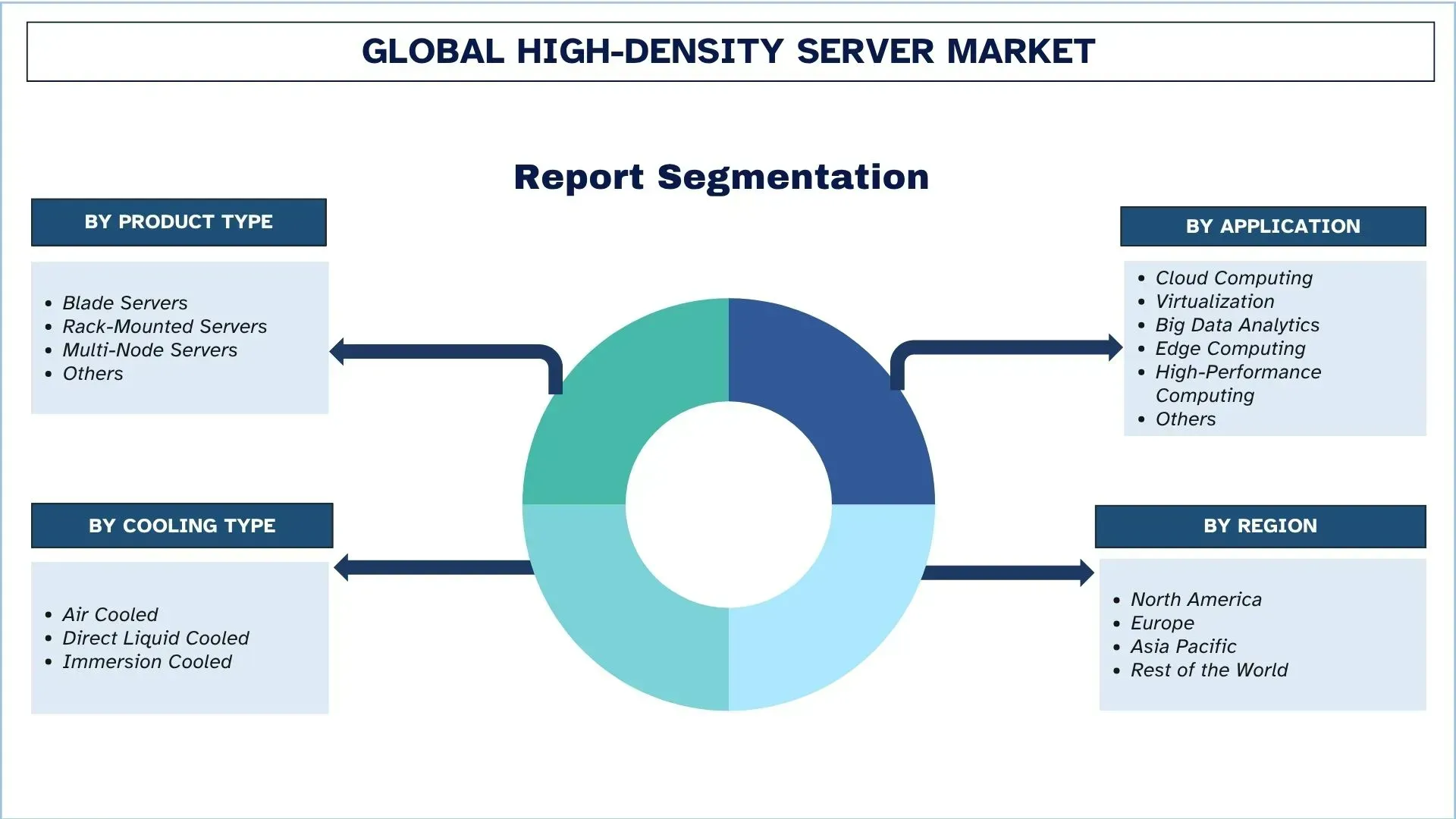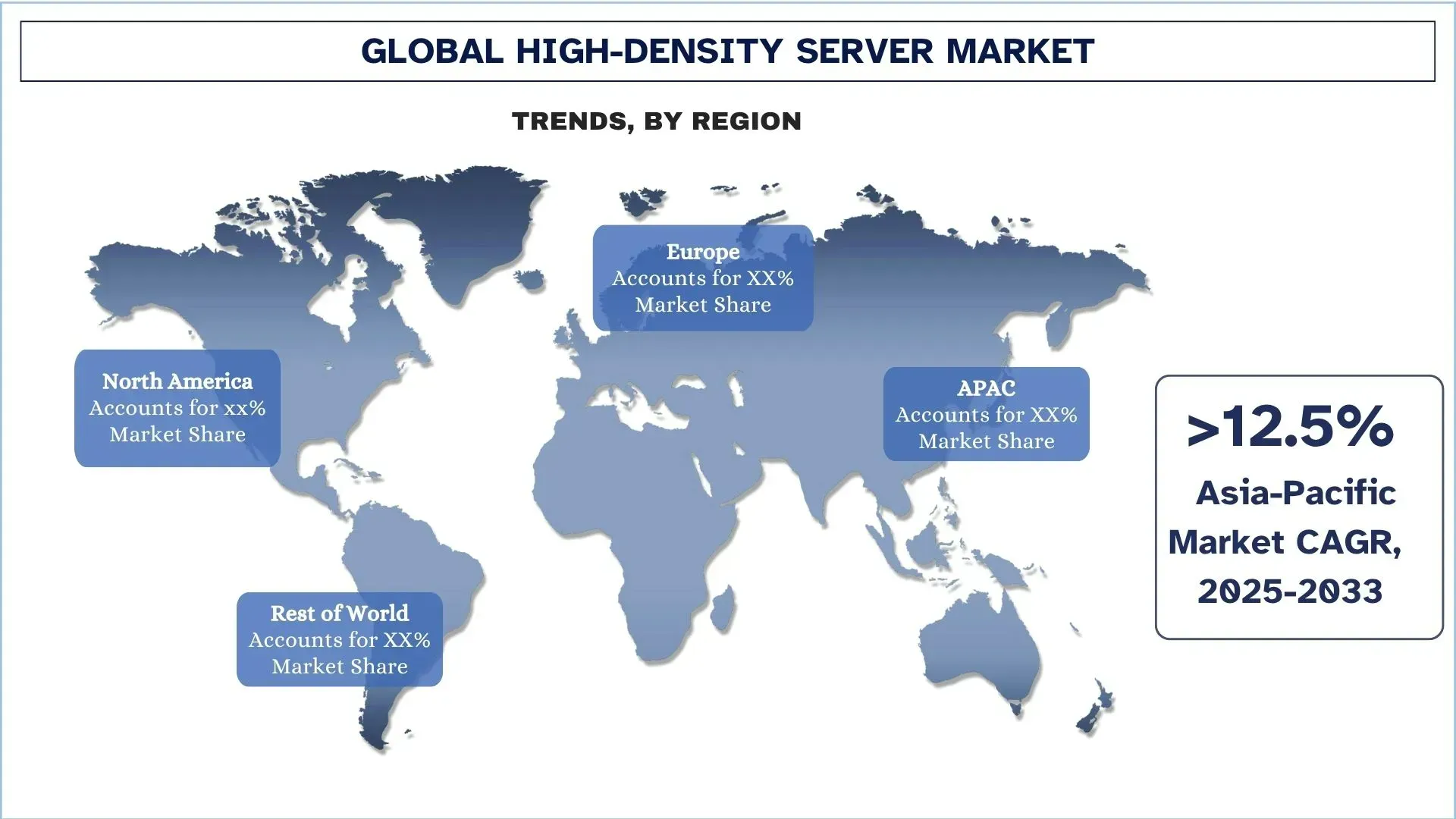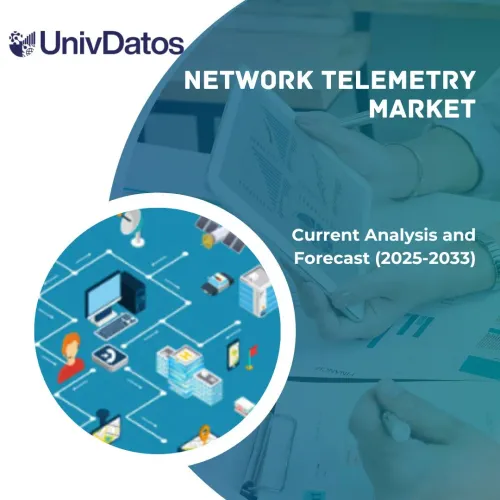- Home
- About Us
- Industry
- Services
- Reading
- Contact Us
High-Density Server Market: Current Analysis and Forecast (2025-2033)
Emphasis on Product Type (Blade Servers, Rack-Mounted Servers, Multi-Node Servers, and Others); Cooling Type (Air Cooled, Direct Liquid Cooled, and Immersion Cooled); Application (Cloud Computing, Virtualization, Big Data Analytics, Edge Computing, High-Performance Computing, and Others); and Region/Country

Global High-Density Server Market Size & Forecast
The global high-density server market was valued at USD ~12,552 million in 2024 and is expected to grow to a strong CAGR of around 10.9% during the forecast period (2025-2033F), driven by the growing demand for scalable computing power to support cloud services, big data analytics, and AI workloads.
High-Density Server Market Analysis
A high-density server is a type of server designed to maximize computing power and storage capacity within a compact physical footprint. These servers are mostly deployed in data centers and enterprise environments where space, power, and cooling are limited resources. Additionally, the increasing need for high computing efficiency to support data-driven applications, such as artificial intelligence, big data analytics, and cloud computing, is increasing the high-density server market. Moreover, efficient processor technologies and advanced cooling solutions make high-density servers more viable and scalable, therefore, leading to their market growth.
Global High-Density Server Market Trends
This section discusses the key market trends that are influencing the various segments of the global high-density server market, as found by our team of research experts.
Shift Toward Liquid & Immersion Cooling
Immersion cooling is on the rise and advancing as a new direction in the high-density server market, as it is a sophisticated method of dealing with extreme heat in a low-space server setup. Under this technique, the whole servers are immersed in thermally conductive dielectric fluid in order to dissipate heat directly to all parts. This practice minimizes the requirements on the conventional air-cooling systems and lowers the amount of energy as well as operational expenses. Immersion cooling can be of particular value in hyperscale data centers and workloads powered by AI, in which performance requirements are intense. As sustainability and energy efficiency concerns become critical, immersion cooling is likely to become a central design solution for the future of data centers.
High-Density Server Industry Segmentation
This section provides an analysis of the key trends in each segment of the global high-density server market report, along with forecasts at the global, regional, and country levels for 2025-2033.

The Rack-Mounted Servers Segment Dominates the Global High-Density Server Market
Based on the product type category, the market is categorized into blade servers, rack-mounted servers, multi-node servers, and others. Out of these, rack-mounted servers currently hold the maximum market share because of their universal utilization, ability to expand, and compatibility with other data center infrastructures. They are flexible, cost-efficient, and are well-suited to cover a wide variety of applications within enterprises and hyperscale data centers, leading to their dominance in the market. However, the multi-node server segment will grow at the highest rate in the future with the growth in the demand for high-performance computing, space efficiency, and energy efficiency.
The Cloud Computing Segment Dominates the Global High-Density Server Market
Based on the application category, the market is categorized into cloud computing, virtualization, big data analytics, edge computing, high-performance computing, and others. Among these, cloud computing currently holds the maximum market share in the high-density server market due to the booming growth in cloud service providers and the rising demand for cloud-based solutions by large and small businesses. However, the edge computing segment is expected to witness the fastest growth in the future. With the growing number of IoT devices and the expansion of 5G networks, edge data centers will require the implementation of high-performance, compact servers that offer flawless service enhancement.
The Asia-Pacific region is the fastest-growing region in the Global High-Density Server Market.
The Asia-Pacific region is the fastest-growing region in the global high-density server market, owing to high growth in the digital transformation, rising cloud computing applications, and the rise in the construction of data centres in countries such as China, India, and Japan. An increase in internet penetration, proliferation of smartphones, and the desire to process real-time data are contributing to the need to have scalable, high-performance server infrastructure. Moreover, favorable government programs, increased investments by leading cloud service providers worldwide, as well as the rise of domestic tech-entrepreneurs, are triggering the development of the market.
India is the fastest-growing country in the Asia-Pacific High Density Server Market in 2024
India is the fastest-growing country in the Asia-Pacific high-density server market, as the capacity of the data centers within the nation has grown significantly, due to the surge in internet users, 5G coverage, the application of AI, and data-localization requirements, especially among the BFSI and cloud vendors. Metro areas such as Mumbai, Chennai, and Delhi NCR produced a majority of the expansions as MNCs and local leaders keep on investing in the high-density servers with the help of favorable state and federal policies. Moreover, due to the cost advantage, skilled labor, as well as excellent regulatory support, India is receiving a number of investments, making it the regional high-density corporate hub for servers.

High-Density Server Industry Competitive Landscape
The global high-density server market is competitive, with several global and international market players. The key players are adopting different growth strategies to enhance their market presence, such as partnerships, agreements, collaborations, geographical expansions, and mergers and acquisitions.
Top High-Density Server Market Companies
Some of the major players in the market are Hewlett Packard Enterprise (HPE), Dell Technologies, Lenovo, Cisco System, Supermicro, Fujitsu, Penguin Solutions, NEC Corporation, Gigabyte Technology, and ASUS (ASUSTeK Computer).
Recent Developments in the High-Density Server Market
In May 2025– Supermicro, Inc., which is a Total IT Solution Provider, announced the launch of its new Supermicro MicroCloud multi-node solution. This latest high-density server is a 10-node CPU and a 5-node CPU + GPU version, in a 3U form factor, ideal for organizations seeking to optimize space, energy, and cost of their IT infrastructure.
In February 2025– Lenovo announced the launch of three new infrastructure solutions, powered by Intel Xeon 6 processors, designed to modernize and elevate data centers of any size to AI-enabled powerhouses. The solutions include next-generation Lenovo ThinkSystem V4 high-density servers that deliver breakthrough performance and exceptional versatility to handle any workload while enabling powerful AI capabilities in compact, high-density designs.
Global High-Density Server Market Report Coverage
Report Attribute | Details |
Base year | 2024 |
Forecast period | 2025-2033 |
Growth momentum | Accelerate at a CAGR of 10.9% |
Market size 2024 | USD ~12,552 million |
Regional analysis | North America, Europe, APAC, Rest of the World |
Major contributing region | The Asia-Pacific region is expected to dominate the market during the forecast period. |
Key countries covered | U.S., Canada, Germany, U.K., Spain, Italy, France, China, Japan, and India. |
Companies profiled | Hewlett Packard Enterprise (HPE), Dell Technologies, Lenovo, Cisco System, Supermicro, Fujitsu, Penguin Solutions, NEC Corporation, Gigabyte Technology, and ASUS (ASUSTeK Computer) |
Report Scope | Market Trends, Drivers, and Restraints; Revenue Estimation and Forecast; Segmentation Analysis; Demand and Supply Side Analysis; Competitive Landscape; Company Profiling |
Segments Covered | By Product Type, By Cooling Type, By Application, By Region/Country |
Reasons to Buy the High-Density Server Market Report:
The study includes market sizing and forecasting analysis confirmed by authenticated key industry experts.
The report briefly reviews overall industry performance at a glance.
The report covers an in-depth analysis of prominent industry peers, primarily focusing on key business financials, type portfolios, expansion strategies, and recent developments.
Detailed examination of drivers, restraints, key trends, and opportunities prevailing in the industry.
The study comprehensively covers the market across different segments.
Deep dive regional level analysis of the industry.
Customization Options:
The global high-density server market can further be customized as per the requirements or any other market segment. Besides this, UnivDatos understands that you may have your own business needs; hence, feel free to contact us to get a report that completely suits your requirements.
Table of Content
Research Methodology for the Global High-Density Server Market Analysis (2023-2033)
We analyzed the historical market, estimated the current market, and forecasted the future market of the global high-density server market to assess its application in major regions worldwide. We conducted exhaustive secondary research to gather historical market data and estimate the current market size. To validate these insights, we carefully reviewed numerous findings and assumptions. Additionally, we conducted in-depth primary interviews with industry experts across the high-density server value chain. After validating market figures through these interviews, we used both top-down and bottom-up approaches to forecast the overall market size. We then employed market breakdown and data triangulation methods to estimate and analyze the market size of industry segments and sub-segments.
Market Engineering
We employed the data triangulation technique to finalize the overall market estimation and derive precise statistical numbers for each segment and sub-segment of the global high-density server market. We split the data into several segments and sub-segments by analyzing various parameters and trends, including product type, cooling type, application, and regions within the global high-density server market.
The Main Objective of the Global High-Density Server Market Study
The study identifies current and future trends in the global high-density server market, providing strategic insights for investors. It highlights regional market attractiveness, enabling industry participants to tap into untapped markets and gain a first-mover advantage. Other quantitative goals of the studies include:
Market Size Analysis: Assess the current and forecast market size of the global High Density Server market and its segments in terms of value (USD).
High-Density Server Market Segmentation: Segments in the study include areas of product type, cooling type, application, and region.
Regulatory Framework & Value Chain Analysis: Examine the regulatory framework, value chain, customer behavior, and competitive landscape of the high-density server industry.
Regional Analysis: Conduct a detailed regional analysis for key areas such as Asia Pacific, Europe, North America, and the Rest of the World.
Company Profiles & Growth Strategies: Company profiles of the high-density server market and the growth strategies adopted by the market players to sustain the fast-growing market.
Frequently Asked Questions FAQs
Q1: What is the global high-density server market’s current market size and growth potential?
As of 2024, the global high-density server market is valued at USD ~12,552 million. It is expected to grow at a CAGR of approximately 10.9% from 2025 to 2033, driven by increasing demand for data-intensive applications, cloud computing, and AI-based workloads.
Q2: Which segment has the largest market share of the global high-density server market by product type category?
Rack-mounted servers currently hold the largest share in the global high-density server market due to their flexibility, scalability, and widespread use in data centers and enterprise environments.
Q3: What are the driving factors for the growth of the global high-density server market?
Key growth drivers include the rising demand for high-performance computing, expansion of cloud infrastructure, adoption of AI and big data analytics, and the need for energy-efficient, space-saving server solutions in modern data centers.
Q4: What are the emerging technologies and trends in the global high-density server market?
Major trends include the adoption of liquid cooling and immersion cooling technologies for improved thermal management, and the rise of multi-node and modular server designs tailored for AI, HPC, and edge computing workloads.
Q5: What are the key challenges in the global high-density server market?
Key challenges include the high upfront costs of server deployment and infrastructure, as well as power consumption and heat management issues in compact, high-performance computing environments.
Q6: Which region dominates the global high-density server market?
North America dominates the global high-density server market, supported by a strong presence of major cloud service providers, advanced IT infrastructure, and substantial investments in hyperscale data centers.
Q7: Who are the key companies in the global high-density server market?
Top players in the high-density server industry include:
• Hewlett Packard Enterprise (HPE)
• Dell Technologies
• Lenovo
• Cisco System
• Supermicro
• Fujitsu
• Penguin Solutions
• NEC Corporation
• Gigabyte Technology
• ASUS (ASUSTeK Computer)
Q8: What investment opportunities exist in the high-density server market for data center operators and technology investors?
The high-density server market presents strong investment potential in areas such as hyperscale and edge data center expansion, advanced cooling technologies, and AI-optimized infrastructure. With growing enterprise demand and regional data localization, investors can explore strategic partnerships, M&A, and technology innovations to gain a competitive advantage.
Q9: How can enterprises and cloud service providers benefit from adopting high-density server solutions?
High-density servers enable enterprises and cloud providers to achieve greater computational power, space efficiency, and energy savings. These benefits translate to reduced operational costs, scalability for AI and big data workloads, and faster time-to-market for digital services.
Related Reports
Customers who bought this item also bought










